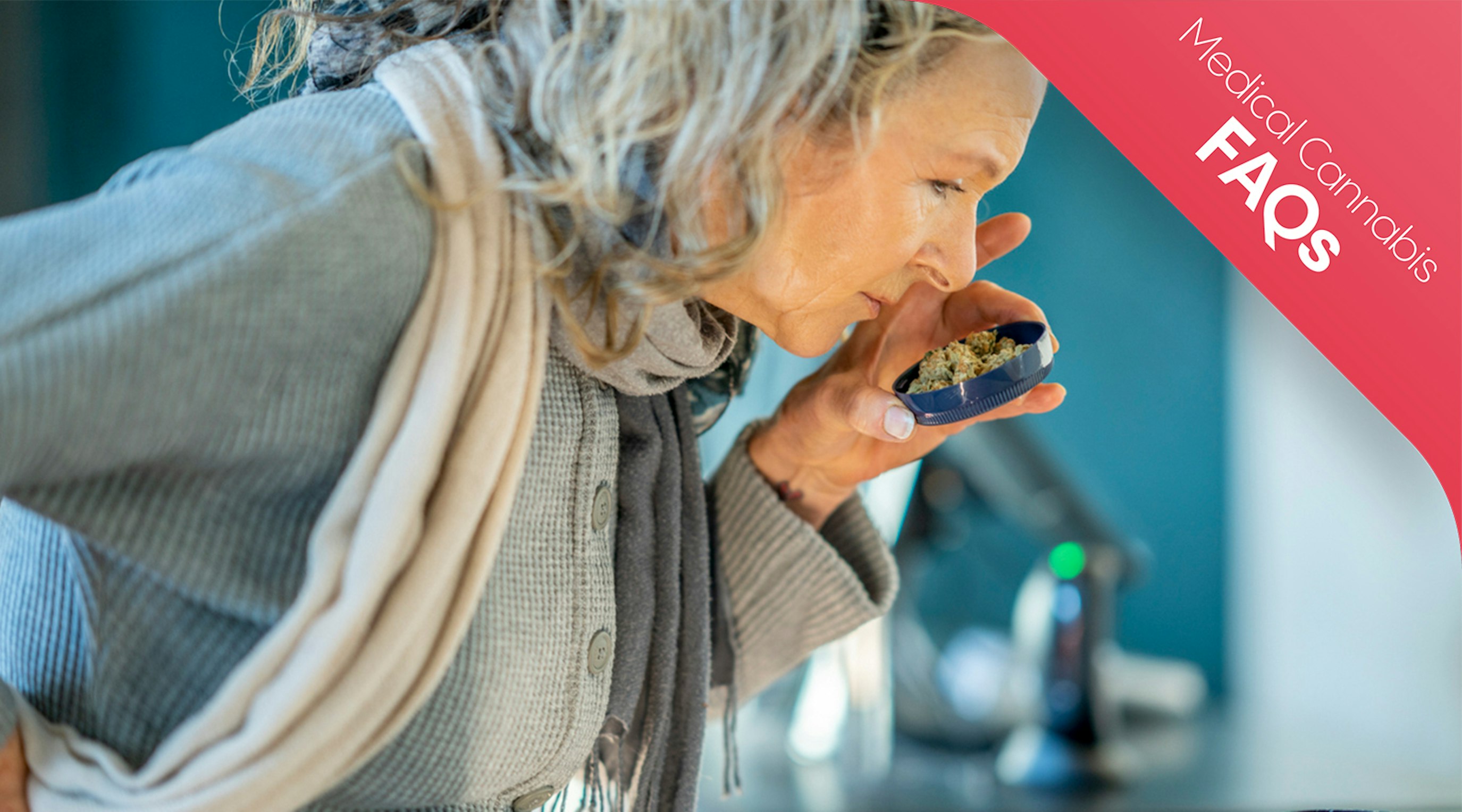What does cannabis smell like, and what causes its aroma?
10 min read
Lucy MacKinnon
Contents
The Cannabis genus, or the Cannabaceae plant family, contains a number of different plant species, each of which produces different variants, or cultivars, of cannabis plants that are colloquially known as strains.
In the broad sense of scents, cannabis has an easily recognisable aroma, and to the untrained nose, most cannabis plants and cannabis aroma profiles probably smell the same. This is because many cultivars within the cannabis genus contain the same chemical compounds, which form these scent archetypes.
However, in fact, each of these cultivars, or cannabis plant species, smells slightly different - because these compounds vary in concentration from strain to strain.
Why do different cannabis strains smell different?
Each cannabis cultivar, or strain, has its own diverse molecular makeup of aromatic compounds that all factor into how it smells, so it is difficult to give a concrete cannabis smell description.
Terpenes, flavonoids, and volatile sulphur compounds are the main aromatic compounds within cannabis that are thought to influence its scent, and their presence affects how the plants overall aroma.
As well as these compounds, the plant’s freshness, when it was harvested, and the end product the plant is manufactured into, also all impact the smell and aroma of a particular cannabis plant. The unique combination of each of these factors gives each cannabis cultivar, or strain, its own unique scent.
This can be replicated in standardised, controlled environments, such as when curating medicinal cannabis, but a completely standardised scent from batch to batch is, understandably, rarely achieved by novice cultivators, due to this large number of variables.
So, what are volatile sulphur compounds?
The underlying ‘skunky’ or sulphuric like-smell to cannabis is believed to be attributed to a family of volatile sulphur compounds, or VSCs in cannabis. Much like terpenes, volatile sulphur compounds are the origin source of many natural scents, and they are particularly odorous.
One particular VSC, namely 3-methyl-2-butene-1-thiol or Prenythiol, is found abundantly in pungent, strong smelling cannabis cultivars, and is believed to be the main culprit, or primary odorant, for cannabis’ skunky smell.
Recent findings from greenhouse experiments also determine that the levels of Prenythiol in cannabis increase significantly during the last stages of the flowering process, and reach their maximum potency during the curing stage.
These same experiments determined that after ten days of storage, the level of present VSCs drops dramatically, which explains why fresh cannabis has such an intense smell in comparison to that that has been stored for a number of weeks.
How do terpenes affect cannabis’ aroma?
Other identifiable traits within cannabis’ aroma can be attributed to the terpenes the species contains. Terpenes are a type of natural compound that can be found in all different kinds of plants from flowers, to fruits, to herbs, and spices.
Over 400 different types of terpenes have been discovered in cannabis plants around the world, and each terpene has its own characteristic profile, which can contribute to the scent, or therapeutic value of cannabis.
With its base note believed to be created by VSCs, terpenes add extra dimensions to the smell of cannabis cultivars, and can influence the plant to smell more sweet, spicy, or sour, and so on, depending on their concentration within the plant.
This is why some cannabis cultivars, or strains, smell more earthy or musky, whilst others smell citrusy or floral.
Some of the most commonly found terpenes in cannabis are:
- Limonene - smells like citrus, and can also be found in lemon and orange trees.
- Linalool - has a floral and herbal scent, and is also found in chamomile and lavender.
- Pinene - as its name suggests, this terpene can also be found in pine trees and gives them their distinctive, woody, piney aroma.
- Myrcene - typically smells earthy or musky, but can add sweet elements to the aroma. Myrcene is also found in lemongrass, hops, thyme, and even in mango.
- Beta-caryophyllene - has a peppery, spicy and slightly woodsy smell, and is naturally also found in cloves and hops.
- Humulene - has an earthy and slightly bitter or spicy scent, and is also found in ginseng.
Can flavonoids impact the taste and smell of cannabis?
Although like terpenes, flavonoids have also been found to be abundantly present in different plant species across nature, the scientific research into this class of chemical compound is limited in comparison to terpenes.
It is believed that flavonoids, or cannaflavins - which are a type of flavonoid only found within cannabis - can influence cannabis’ characteristics in a number of ways, including the way it smells, tastes and looks.
Working synergistically with the terpenes present, which admittedly do most of the scent related leg work, cannaflavins can affect aroma, whilst dictating its flavour as a flower, and often its colour as well.
Currently, it is generally accepted that flavonoids have a minor influence on cannabis’ aroma in comparison to terpenes and VSCs’, but they are still believed to contribute, and so, still warrant a mention.
What other factors influence the way cannabis smells?
Just like with its other characteristic features, over time, cannabis cultivators can design and curate their plants to have a particular smell. This is done through selected breeding processes, capturing certain characteristics they’d like to replicate or adapt to create a new hybrid species.
Sometimes this involves breeding plants that contain especially high levels of VSCs to produce a plant that is particularly pungent, or breeding plants with terpenes that have more of a conventionally pleasant smell, such as limonene and linalool, to improve the sensory experience for the consumer.
Cannabis harvesting and aroma
Another factor that influences the way cannabis smells is when it is harvested. Typically, the later cannabis is harvested, the more potent it smells. This is because its terpenes and VSCs, much like its cannabinoid contents, are continually produced as the plant matures, and reach their peak level once the cannabis plant reaches full maturity.
The form in which cannabis has been manufactured into, or is sold in as its end product, also affects the way it smells. Just like when cooking, when cannabis is heated, its aroma intensifies and alters slightly, and so, when dried cannabis flower is vaped - it has a different scent to a cannabis-based tincture for example.
Cannabis storage and smell
Other factors during the growing, harvesting, drying, or storage stages can all also influence or change the way a particular cannabis cultivar smells. Contaminants or impurities such as mould can cause cannabis to develop mycotoxins, which have a musty, stagnant odour that can penetrate the plant and take over its natural aromas and flavours.
As well as ruining the taste and smell of cannabis, mycotoxins can be extremely dangerous to health - so their pungent smell acts as a front line defence - warning consumers something isn’t quite right with their cannabis.
Cannabis aroma and smell FAQs
What does cannabis smell like?
The almost unbelievable range of cannabis cultivars now available, with their varying terpene profiles and cannabinoid contents, means that there isn't really a one-scent-fits-all answer to this question.
Classically, cannabis is thought to be on the musky, earthy, dank side of the fragrance spectrum - but, with so many unique cultivars now around, it can also smell floral, fruity, spicy and more. In fact, some cultivars don't have much of a smell at all.
Can cannabis be smell-proof?
That depends on what you mean by 'smell proof'.
Cannabis has a very distinctive and potent aroma, so it can be difficult to mask completely. Storing it in an air-tight, fully sealed container can go a long way to stopping the smell from escaping and being detected. However, if you are concerned about being discreet, there are now specially designed containers that have been created specifically to minimise cannabis' strong scent. These containers often use carbon filters or other odor-absorbing materials to trap and reduce the punchy smell.
Can you remove the smell of cannabis?
Yes, the smell of vaporised cannabis can be easily removed from a room by using an air purifier or ventilation system. Even just opening a window for a few minutes should do the trick. If you are concerned about the aroma of cannabis lingering on clothes, skin, and hair - it is best to allow some time after usage for its smell to dissipate before heading out in public.
Does vaporised cannabis smell as strongly as smoke?
No, it doesn't.
Vaporisation of cannabis uses a lower temperature and with that comes reduced emission of volatile compounds, as well as being a more uniform way of consuming - so the smell is naturally less pungent and better controlled.
Is the smell of cannabis dangerous?
No, the smell of vaporised cannabis is not dangerous.
While the smell alone is not harmful, sensitive groups such as children and pregnant women might benefit from avoiding strong scents. This is more about general precaution rather than a direct health threat.
Does cannabis have essential oils?
Cannabis does not produce essential oils in the same way as plants like lavender, tea tree, or eucalyptus. However, it contains terpenes, which are the primary building blocks of essential oils.
Terpenes such as myrcene, limonene, and pinene give cannabis its distinctive aroma and may contribute to its therapeutic effects. While cannabis essential oil can be extracted, it contains only trace amounts of cannabinoids and is primarily made up of terpenes.
Do cannabinoids have a smell?
Cannabinoids like THC and CBD are odourless in their pure, isolated form. Terpenes are primarily responsible for the distinctive smell of cannabis, not cannabinoids.
Conclusion
The aroma and smell of cannabis is a complex and multifaceted aspect of this fascinating and versatile plant. From genetics to cultivation techniques, harvesting processes to storage methods - there are many factors that can influence the way cannabis smells.
And with so many unique cultivars available on the market, each with its own distinct terpene profile, the scent of cannabis has become even more diverse and intriguing. Whether you prefer musky, floral or fruity scents - one thing's for sure, there is a cannabis strain out there that will suit your olfactory preferences perfectly.
Don't let the stigma surrounding medical cannabis prevent you from getting a suitable treatment. Releaf provides tailored monthly packages, specialist consultations for medical cannabis, and a unique medical cannabis card for protection, all based on your medical cannabis prescription.
Want to learn more?
Our blog and education pages are packed with valuable information for patients and anyone interested in cannabis-based medicines. Don't forget to follow us on Instagram and LinkedIn for the latest updates on medical cannabis and Releaf.
Share article
Did you like this article?
It is important to seek medical advice before starting any new treatments. The patient advisors at Releaf are available to provide expert advice and support. Alternatively, click here to book a consultation with one of our specialist doctors.
Elevate your wellness with medical cannabis
Get comprehensive care, convenience, and confidence with an all-in-one treatment plan.
Am I eligible?Authors
With five years of journalism and healthcare content creation under her belt, Lucy strives to improve medical cannabis awareness and access in the UK by producing high quality, credible content.
fact checked
Compliance Director
Editorial Policy
All of our articles are written by medical cannabis experts, guided by strict sourcing guidelines, and reference peer-reviewed studies and credible academic research. Our expert clinical team and compliance specialists provide valuable insights to ensure accuracy when required. Learn more in our editorial policy.
Need more help?











